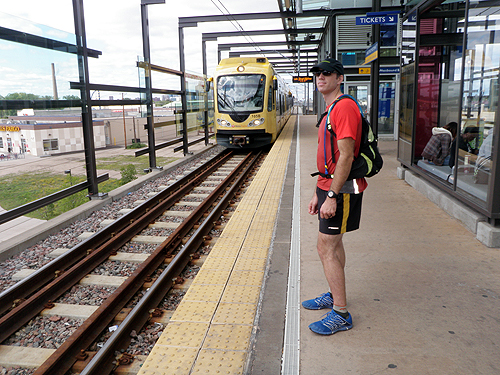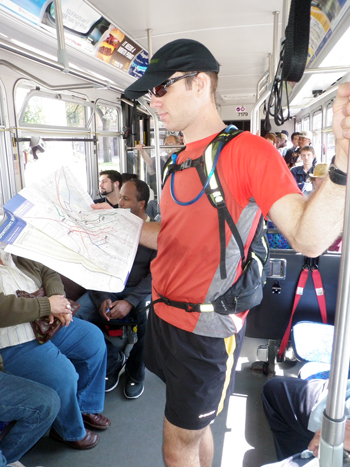The blast of a bullhorn siren signaled the start of the event. Competitors scrambled in all directions, 112 racers running off with water bottles and iPhones in hand. It was a Saturday in August at Minnehaha Falls Park in Minneapolis, and the inaugural Great MN Race had begun. Fifty-two teams of two grabbed their race guides and departed on a choose-your-own adventure through the city.
Modeled in part after “The Amazing Race,” a reality-television show where teams race around the world for $1,000,000, urban scavenger hunts like the Great MN Race have cropped up in the United States by the dozens. Part physical feat, part mental challenge, urban scavenger hunts mix aerobic output with logistical skills, map reading, teamwork, and ad hoc problem solving at checkpoints around a city. You might sprint a mile through town to a manned station stocked with Sudoko puzzles.

(Click for ‘AMAZING RACE’ PHOTO GALLERY)
Public transit, including buses and trains, are often legal. But foot travel can be quicker. Wait at a bus stop or run? In an urban race, competitors pick their mode of movement from challenge to challenge throughout a city. “Running versus taking a bus can provide a big edge,” said Carl Schwab, director of the Great MN Race. “Or hit the streets until the buses catch up.”
The winning squad at Schwab’s event, Team Oozing Monkeys, blazed the course in about 2.5 hours. They took buses, a light-rail train, and they ran miles on sidewalks. “We ran all around the city — maybe five or six miles total,” said Catherine Lee, who with her husband and teammate, Terrance, won $500 at the August event.

(Click for ‘AMAZING RACE’ PHOTO GALLERY)
I raced with a friend, Stanley Barton, and came prepared with a backpack, energy bars, and a city street map. Stanley brought a smartphone to look up addresses and decipher clues — a technological edge that’s allowed by race organizers as a tool to parse the complex course. For the Great MN Race, a total of 12 challenges were outlined in a guidebook. Each team had to pick eight of the 12, including challenges like a bocce ball toss, a photo feat at the base of a waterfall, and a task that necessitated selling coffee to strangers.
At the sound of the bullhorn siren, Stanley and I ripped open our race packet and sat at a picnic table. I scanned the checkpoint and challenge descriptions, sketching a rough map on the back of an envelope. Stanley typed manically on his phone. “Where the heck is the fire museum?” he said, squinting at the small screen.

(Click for ‘AMAZING RACE’ PHOTO GALLERY)
We ran west after 10 minutes of plotting and mapping a route. A public train line would bring us north toward our first checkpoint clue at a station. “Darn slow connection,” Stanly shouted, waiting for a Web page on the phone to load.
Within an hour, we’d visited a gift shop with a giant bobble-head doll, copied a historic plaque with a crayon and blank paper, tossed bocce balls in a ring, and convinced a local music group to pose for a photo. But on Central Avenue, a busy road near downtown, we hit a wall. The race clock ticked for more than 10 minutes as we idly waited for a bus. Once onboard, the bus seemed to hit every red light on its journey north. “Come on!” Stanley shouted, as the bus groaned again and again to a halt.
After a strange checkpoint challenge at a firefighters museum, we ran back toward downtown. “Forget the bus,” I shouted, sprinting south on a sidewalk. But back in downtown, sweaty and with a long way still to go, we scanned a bus schedule and caught a No. 5 bus to another part of town.

(Click for ‘AMAZING RACE’ PHOTO GALLERY)
An indoors scavenger hunt at a youth center was our final stop before a sprint and a train ride to the finish line back at Minnehaha Falls Park. In the end, our route through the city took three hours and 38 minutes — quick enough to earn us third place overall. Team Oozing Monkeys had beat us by an hour. Another squad, Team Smith Bros., edged out Stanley and I by eight minutes.
Next time we’ll copy the Monkeys, running more and sitting on buses less. And we’ll pause at the start to find a faster connection for the phone — a stronger signal netting quicker clues before we head off again on a long urban sprint.
—Stephen Regenold writes about outdoors gear at www.gearjunkie.com.






